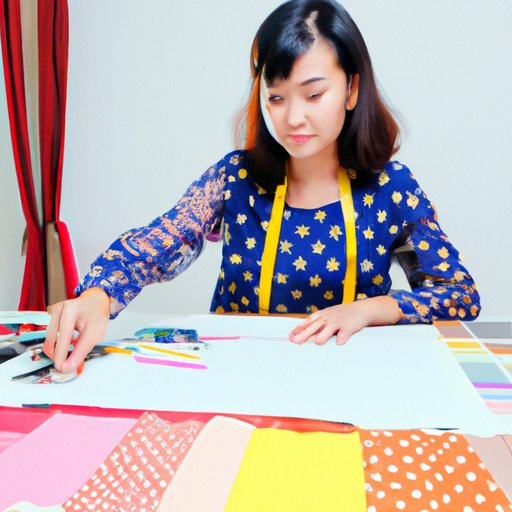I. Introduction
Becoming an interior designer or a fashion designer is a dream for many. However, the question of which profession pays better is not easy to answer. Both professions have high earning potential, but it depends on several factors. In this article, we will compare the salaries of interior designers and fashion designers based on different criteria and explore the factors that affect their earnings.
II. Comparison of Salaries Between Interior Designers and Fashion Designers
The salary of interior designers and fashion designers varies based on multiple factors. According to the U.S. Bureau of Labor Statistics (BLS), the median annual salary for interior designers in 2020 was $57,040, and the median hourly wage was $27.43, while the median annual salary for fashion designers was $75,810, and the median hourly wage was $36.46.
However, it should be noted that the nature of work for both professions is different, and so is the earning model. Interior designers typically charge hourly or flat fees, while fashion designers can earn their income via a commission or salary.
Real-life examples of earning potential for both professions vary based on location, years of experience, and other factors.

III. Factors Influencing Earnings of Interior Designers and Fashion Designers
Salaries can vary based on several factors, and location plays a crucial role. For instance, interior designers and fashion designers working in metropolitan cities such as New York and Los Angeles tend to earn more than those working in rural areas.
Years of experience also play a significant role in determining earnings. Interior designers and fashion designers with more experience can command higher rates and salaries.
The type of employer also tends to affect an individual’s earning potential. Self-employed interior designers and fashion designers tend to earn more, but the level of job security is much lower than working for a large corporation.
Personal brand and reputation have a significant impact on the salary of interior designers and fashion designers. Well-known designers with established brands can command premium fees.
IV. Job Outlook for Interior Designers Vs. Fashion Designers
The BLS has predicted a 4% growth rate for interior designers over the next decade. The growth rate for fashion designers is expected to be slower at 1%. With increasing demand for eco-friendly design, residential refurbishments, and the advent of virtual design platforms, the future looks bright for the interior design profession.
In contrast, the fashion design industry has faced challenges in recent years. The retail industry has been disrupted due to the COVID-19 pandemic, and fashion designers are finding it challenging to adapt to the changing times.
V. Skills and Qualifications Needed to Succeed as an Interior Designer or Fashion Designer
To succeed as an interior designer or fashion designer, individuals must possess the necessary technical skills, educational qualifications, and soft skills.
Interior designers require a bachelor’s degree in interior design or a related field and must have proficiency in design software such as AutoCAD, SketchUp, and 3D rendering tools.
Fashion designers typically require an associate or bachelor’s degree in fashion design, with courses in computer-aided design (CAD), textiles, and fashion history.
Both professions require excellent communication skills, problem-solving abilities, creativity, and a good sense of style.
VI. Impact of Skills and Qualifications on Salary
Individuals with the right combination of skills, education, and experience can command higher salaries. Interior designers and fashion designers with advanced degrees and a vast portfolio of work can charge a premium.
According to a salary survey by Glassdoor, the average annual salary for an interior designer with a master’s degree is $67,000. A fashion designer with a bachelor’s degree can earn an average of $65,000 annually.
VII. Should I become an Interior Designer or a Fashion Designer: Pros and Cons
Both professions have their fair share of pros and cons. Interior designers get to transform spaces and make a significant impact on people’s lives. They have flexibility in their schedules and have the potential to earn high salaries. However, the design process can be stressful, and the job can be physically demanding.
Fashion designers get to express their creativity and make a name for themselves. They work in exciting environments and have plenty of opportunities for travel. However, the fashion industry is highly competitive, and the job can be physically exhausting with long hours and tight deadlines.
In the end, the choice between interior design and fashion design comes down to personal preferences, skills, and aptitude.
VIII. Conclusion
In conclusion, the earning potential for interior designers and fashion designers is high. However, the salary figures can vary based on numerous factors such as location, years of experience, and employer type. To succeed in either profession, individuals must possess the appropriate skills, education, and soft skills. While there is no definitive answer to the question of which profession pays better, the choice boils down to personal preferences.
Additional resources for learning more about these professions include the International Interior Design Association and the Council of Fashion Designers of America.
(Note: Is this article not meeting your expectations? Do you have knowledge or insights to share? Unlock new opportunities and expand your reach by joining our authors team. Click Registration to join us and share your expertise with our readers.)
